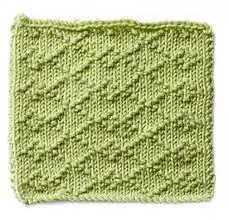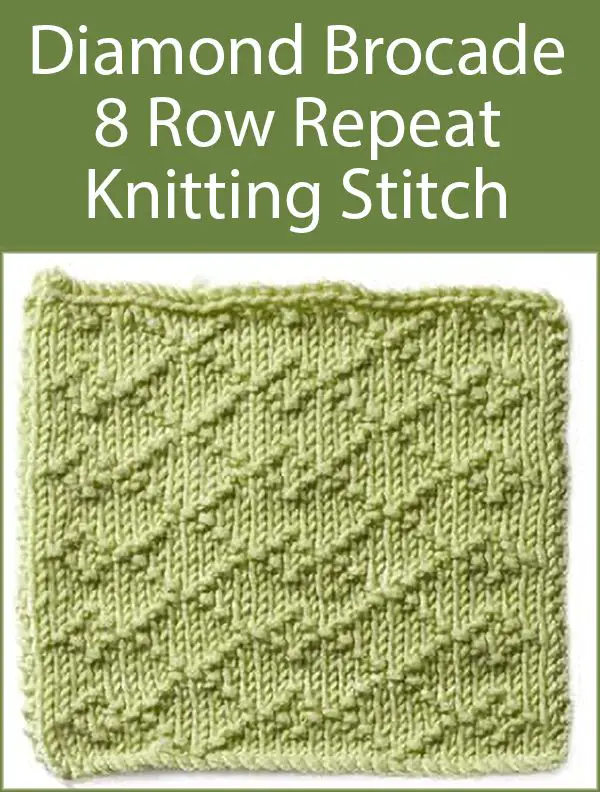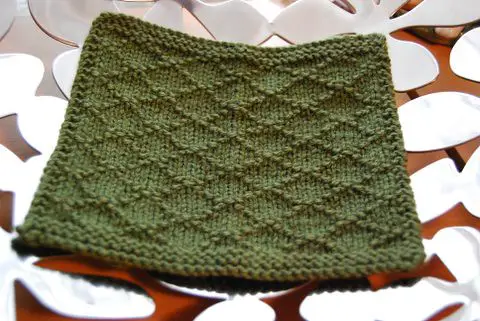In this article, you’ll learn how to knit the classic Diamond Brocade stitch. The diamonds seem slightly higher owing to the mix of knit and purl stitches, which is an exquisite knitting design. However, it’s really simple to execute, and although it’s not reversible, the “wrong” side of the piece looks unique as well. On the difficulty scale, it’s probably somewhere between intermediate and easy.
The diamond brocade stitch pattern has been around for a long time and is a really lovely design. Brocading is a technique that involves weaving elaborate and attractive patterns and ornaments into cloth. The fabric was originally constructed of gorgeous silks with gold or silver threads woven throughout. The brocading also included precious stones such as diamonds and rubies. Although it was incredibly heavy, it added a layer of warmth to the cloth. Beads and sequins are now often used in place of precious stones, and although silk is still used, cotton, rayon, and polyester are too. All of the results are stunning.
The Diamond Brocade basic knitting stitch design uses simple knit and purl stitches to produce gorgeous diamond patterned stitches over the cloth. That being said, it is ideal for novices. So how do you do a proper diamond brocade stitch? Read on and find out.

Diamond Brocade Pattern
Add 1 additional stitch to a multiple of 8 stitches.
You’ll need to cast on 17, 25, or 33 stitches if you want to knit a sample.
1st Row: (Right side) Knit 4, *purl 1, k 7; repeat from * until 5 stitches remain, purl 1, knit 4
2nd and 8th Rows: (Wrong side) Purl 3, *k 1, purl 1, knit 1, purl 5; repeat from * until 6 stitches remain, knit 1, p1, k1, purl 3
3rd and 7th Rows: K 2, *purl 1, knit 3; repeat from * until 3 stitches remain, p 1, knit 2
4th and 6th Rows: Purl 1, *knit 1, p 5, knit 1, purl 1; repeat from * to end.
5th Row: *Purl 1, knit 7; repeat from * until 1 stitch remains, purl 1.
8th Row: Purl 3, *knit 1, p 1, knit 1, purl 5; repeat from * until 6 stitches remain, k 1, purl 1, knit 1, purl 3.
Repeat rows 1 – 8.
While we normally stick to the beginning and easy-level designs and stitches, it helps to try something different once in a while. Give the diamond brocade stitch a go, otherwise, you might prefer to learn one of the beginner-friendly stitches below.

Other Knitting Stitches for Beginners
Sewing is the physical thread that binds the garment business together. Almost every produced garment is made up of the fabric and the many hand-sewn or machine-made stitches, threads, and finishes that hold it together. It is critical for everyone working in the garment business to be able to distinguish between the many kinds of stitches available today. The most common machine and hand stitches will be introduced and explained in this quick introduction to fundamental sewing stitches.
We hand-picked the following seven easy-to-learn knitting stitches for beginners from among the hundreds of distinct knitting stitches.
These seven stitches will give you a head start in the world of knitting, allowing you to create a variety of textures and patterns for your projects. Indeed, you could make gorgeous hats, scarves, cardigans, and blankets with just these seven stitches and never learn another stitch — but where would the pleasure be in that?
7 Easy to Learn Knitting Stitches for Beginners

Knit and Purl are the two ways or stitches that make up the following seven stitches, therefore knowing what they are is important. Knit and purl are both used to sew garments, and they are often combined. Knit and purl are similar in that they are both employed in fabric, however, there is a tiny variation between them.
The fundamental distinction between knit and purl is the stitching technique. The needle moves inside up and behind the thread in the Knit stitch. Purl stitch, on the other hand, has the needle going down and in front of the stitch.
Knit stitches have an almost V-shaped pattern and are flat. A purl stitch, on the other hand, creates a narrow horizontal bar that bounces out a bit. A purl stitch may be thought of as the inverse of a knit stitch, and vice versa. A purl stitch on one side will seem to be a knit stitch on the other side in this situation.
Knit stitch is often used to produce stitches on the front part of the garment, or the area that is visible from the outside. Purl stitch, on the other hand, is usually evident on the fabric’s backside or in an undetectable area. Now that you know how to knit and purl, let’s start with the seven basic knitting stitches for beginners:
1. Garter Stitch
For the majority of individuals, the Garter Stitch is their first step into the world of knitting since it is one of the simplest and most prevalent stitch patterns used in knitting projects.
This stitch has a harsh appearance and is made up of a sequence of horizontal ridges that feel bumpy to the touch and are made up of the tops of knitted loops on every other row.
2. Stockinette Stitch
The Stockinette Stitch incorporates both knit and purl methods. The outcome is a fabric that looks like a garter on the right side and has smooth rows of stacked “V”s on the right side.
3. 1×1 Rib Stitch
The simplest of the Rib Stitches is the 1×1 Rib Stitch. The stitch is once again a mix of the two most basic methods, knit and purl. By casting on an even number of stitches and then knitting and purling each stitch alternately, the stitch produces a raised vertical rib structure.
4. Seed Stitch
The Seed Stitch is a wonderful knit/purl repeat stitch and is a reversible stitch that can be used to create more complicated patterns and textures when combined with other stitches.
5. Moss Stitch
The Moss Stitch is quite similar to the Seed Stitch described above. In the United Kingdom, this stitch is known as the Double Seed Stitch or the Double Moss Stitch. It’s another fantastic example of mixing knit and purl methods to produce a lovely texture.
6. Basketweave Stitch
The Basketweave Stitch may seem to be a difficult pattern, but because I’m confident you’ve mastered both the knit and purl methods, this fantastic stitch should be a breeze. The stitch has a unique texture, and it’s easy to see where it earned its name! There are various versions of this basic 4×4 version of the basketweave pattern.
7. Purl Ridge Stitch
The Purl Ridge Stitch is a straightforward variant of the Stockinette Stitch. You can make these lovely purl bumps by simply adding a row of knitted threads. It’s another fantastic example of mixing knit and purl methods to produce a lovely texture.
What is the easiest stitch to knit?
For the majority of individuals, the Garter Stitch is their first step into the world of knitting since it is one of the simplest and (perhaps as a consequence) most common stitch patterns used in knitting projects.
Which knitting method would you use to make a textured diamond pattern?
The Fancy Diamond Stitch Knitting Pattern results in a huge diamond nested inside zigzag outer rows. Knitted using a blend of Garter, Stockinette, and Reverse Stockinette stitches, it is a visually stunning pattern.